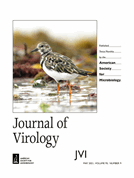AI SummaryThe article discusses how the PB2 residue 473 of the H7N9 avian influenza virus plays a role in the virus’s ability to infect mammals. This residue influences viral polymerase activity through interaction with the host protein ANP32A. This finding could provide insight into developing strategies to counter the virus’s ability to infect and spread… Continue reading PB2 residue 473 contributes to the mammalian virulence of H7N9 avian influenza virus by modulating viral polymerase activity via ANP32A
Tag: Emerging Viruses
Avian influenza virus is adapting to spread to marine mammals
AI SummaryThis article discusses a study that has found that the avian influenza virus H5N1 has adapted to spread between birds and marine mammals. This suggests that the virus is evolving to infect a wider range of hosts, which could have significant implications for the spread of the virus and the potential for cross-species transmission.Avian… Continue reading Avian influenza virus is adapting to spread to marine mammals
[ASAP] Discovery of JNJ-1802, a First-in-Class Pan-Serotype Dengue Virus NS4B Inhibitor
Editors’ Picks: February 2024 Highlights from AACR Journals
AI SummaryThis article compiles highlighted studies from various AACR Journals in February 2024 focusing on cancer research. The selected studies explore topics such as treatment resistance in multiple myeloma and the role of ETV4 in maintaining MYC expression, alveolar differentiation in lung adenocarcinoma affecting response to KRAS inhibitors, racial disparities in accessing cancer genetic services,… Continue reading Editors’ Picks: February 2024 Highlights from AACR Journals
The H9N2 avian influenza virus increases APEC adhesion to oviduct epithelia by viral NS1 protein-mediated activation of the TGF-β pathway
Oligoadenylate synthetase 1 displays dual antiviral mechanisms in driving translational shutdown and protecting interferon production
How cells induce the production of antiviral molecules while shutting down protein translation to limit viral replication remains unclear. Here, Harioudh et al. show a non-canonical function for the interferon-induced antiviral protein, OAS1, which sequesters and protects Ifnb mRNA from degradation to sustain innate antiviral protection against West Nile virus.
Japanese encephalitis virus inhibits superinfection of Zika virus in cells by the NS2B protein
TWiV 1091: Skeeter poo and obelisks too
AI SummaryThe content provides a summary of the podcast TWiV 1091, discussing the resurgence of Lassa fever, paralytic cases of cVDPV2, Chronic Wasting Disease from prion-laden plants, measles outbreaks in various locations, SARS-CoV-2 persistent infections, leaky blood-brain-barrier in long COVID patients, West Nile virus transmission among mosquitoes, and viroid-like colonists of human microbiomes. The episode… Continue reading TWiV 1091: Skeeter poo and obelisks too
Prior flavivirus immunity skews the yellow fever vaccine response to cross-reactive antibodies with potential to enhance dengue virus infection
AI SummaryThe study examines the impact of prior flavivirus immunity induced by tick-borne encephalitis virus (TBEV) vaccination on the response to the yellow fever 17D vaccine (YF17D). Results show that pre-existing TBEV immunity enhances YF17D virus infection in vitro through antibody-dependent enhancement (ADE) and leads to the development of cross-reactive IgG antibodies with poor neutralizing… Continue reading Prior flavivirus immunity skews the yellow fever vaccine response to cross-reactive antibodies with potential to enhance dengue virus infection
[Newsdesk] Risk of dengue spread is high globally, says WHO
AI SummarySummary: In 2023, global cases of dengue fever reached a record high, leading to concerns about the continued spread of the disease due to factors such as global warming and human activity. This highlights the need for increased efforts to control and prevent dengue outbreaks on a global scale.Global cases of dengue were at… Continue reading [Newsdesk] Risk of dengue spread is high globally, says WHO



